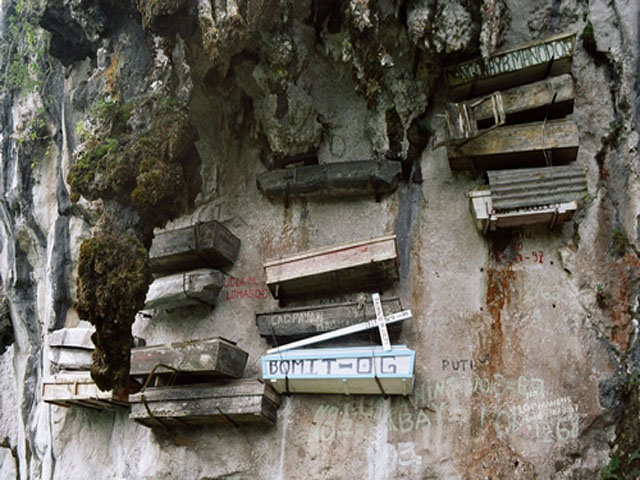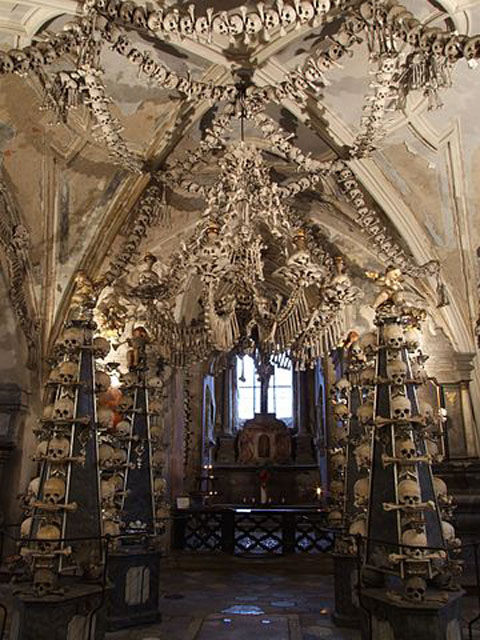Filtered By: Lifestyle
Lifestyle
Beautifully macabre: Remarkable burial grounds around the globe
By VIDA CRUZ, GMA News
How the dead are treated and how their resting place is curated says much about a country's culture and more. Often, a marked prominence of the funerary arts is a sign of healthy respect for the departed and a similarly robust attitude towards passing on.
Here are 10 examples of unusual ossuaries, cemeteries, and necropoli across the world.
Here are 10 examples of unusual ossuaries, cemeteries, and necropoli across the world.

The sprawling necropolis of Emperor Qin Shih Huang took 38 years to build and houses bronze figures of swans, cranes, ducks, and the world-famous Terracotta Army. (Photo: Wit via Wikipedia)
The Merry Cemetery (Sapânta, Romania)
Probably one of the most beautiful cemeteries in the world, Cimitirul Vesel—translated as the “merry cemetery”—in Romania's Sapânta village is one of UNESCO's World Heritage Sites.
Romanian sculptor, painter, and poet Stan Ioan Petras carved many of the oaken crosses and their (sometimes funny) epitaphs. The bright blue in which he painted them is known the world over as Sapanta Blue. Following his death in 1977, his disciple Dumitru Pop has since taken over the cross carving.
While the rest of Europe views death as a somber affair, the Merry Cemetery alone challenges this philosophy, with its humorous epitaphs, bright colors, and scenes depicting the lives of the buried—and sometimes, their deaths.
With such charming grave markers, visitors can't keep their frowns on for long.
Nintoku-ryo (Sakai, Japan)
Sprawling tombs like keyholes is what you get to be buried in if you happened to be born a Japanese emperor several hundred years ago. And the 2.7 kilometer-long Nintoku-ryo tumulus—kofun, or “old mound” in the local language—of fifth century Emperor Nintoku in Sakai, Japan, covers the largest ground of any burial site in the world.
Situated on the outskirts of Sakai, the circular portion is where the deceased are located, while the rectangular portion is where burial rituals and ceremonies were performed. The entire complex is protected by two layers of dense forest, bisected by a moat hugging the unique shape.
The Neptune Memorial Reef (Maine, USA)
The Neptune Memorial Reef in Maine is the world's largest man-made reef and an attractive destination for divers. It also happens to be a 16-acre memorial cremation site, comprised in part by the projected 125,000 remains mixed with cement and marked by memorial plaques shaped like shells and starfish.
Built as an artistic interpretation of the Lost City of Atlantis by the joint efforts of Gary Levine and Kim Brandell, this labor of love features stone lions, a four-pillared canopy of curling metalwork, and humongous gates. Located 40 feet below sea level and five miles off of Florida Bay's Key Biscayne, the project is considered the “ultimate Green Burial.”
The Giza Necropolis (El Giza, Egypt)
One of the Seven Wonders of the World and also a World Heritage Site, the Giza Necropolis is a marvel of the ancient world. The three Great Pyramids and the Sphinx dwarf the workers' village, industrial complex, and cemeteries littered around them.
Three pharaohs and one queen are buried here, each with a pyramid complex housing boat pits, the pyramids of spouses, causeways, mortuary temples, Valley Temples, and the temple of the ruler.


Indigenous funerary rituals entail the elderly hollowing out logs for their own coffin and then the newly-dead are squashed into a box and then hung on the side of the cliffs of Sagada. (Photo: Maurice Yeo via Wikipedia)
The Sedlec Ossuary (Kutná Hora, Czech Republic)
On the macabre end of the spectrum of attitudes toward death, in another part of Europe, in the neat little suburb of Kutná Hora in the Czech Republic, beneath the Cemetery Church of All Saints, there lies the famous Kostnice v Sedlci, or the Sedlec Ossuary.
On the off chance that one ever thinks of an ossuary, the image that comes to mind is a little room with skulls either in a heap or in neat rows—but this ossuary is instead decorated with the bones of its occupants, from the lurid bone chandelier (said to have at least one of every bone of the human body) to the humongous Schwarzenberg family crest hanging before one of the alcoves.
The Sedlec Ossuary used to be the most desired burial site in Central Europe, since one of the monks was said to have brought back a soil sample from the Holy Land and sprinkled it there. In life, its 40,000 to 70,000 skeletons were, among those who died of old age and accidents, victims of war and the Black Plague.
Taj Mahal (Uttar Pradesh, India)
Mughal emperor Shah Jahan loved his wife Mumtaz Mahal so much that he not only had 14 children with her, he had the Taj Mahal built to memorialize her after she died at the birth of their youngest.
The Taj Mahal is 17 acres across and features many buildings in its complex, such as a guest house—the whole thing was built from 1632 to 1648, with a few more structures added in 1653. Its overall symmetry has earned it the status of World Heritage Site, a marvel of architecture.
Hanging Coffins (Mountain Province, Philippines)
It may seem morbid to carve out your own coffin or that of your loved one, but that is exactly the tradition at Sagada, in the Mountain Province, where the elderly hollow out logs for their final resting places, or their sons do it for them when the former are too ill to continue.
The newly-dead are then squashed into the box—never mind that bones will be broken—and hoisted up to the caves atop the cliffs of Sagada. They will be joining their ancestors there alongside other hanging coffins, some of whom have been resting on the site for over 2,000 years.
The newly-dead are then squashed into the box—never mind that bones will be broken—and hoisted up to the caves atop the cliffs of Sagada. They will be joining their ancestors there alongside other hanging coffins, some of whom have been resting on the site for over 2,000 years.
On the practical side, grave robbers won't be able to get to many of the coffins hanging from the cliff's sides. This arrangement has, however, failed to deter a few tourists in the cave areas, who appear to have no qualms taking bones as souvenirs.
The Mausoleum of the First Qin Emperor (Shaanxi, China)
Another World Heritage Site, the final resting place of Qin Shih Huang, some of his horses, and hundreds of forced laborers took 38 years to build.
This expansive necropolis is symbolic of the emperor's expansive empire, as it contains a good drainage system; bronze figures of swans, cranes, and ducks; and terracotta figures of entertainers, courtesans, and the world-famous Terracotta Army. The tomb has yet to be fully excavated.

The Sedlec Ossuary in the Czech Republic's 40,000 to 70,000 skeletons comprise those who died of old age and accidents, victims of war, and the Black Plague. (Photo: Marcin Szala via Wikipedia)
Shirokorechenskoe Cemetery (Yekaterinberg, Russia)
Even in death, mafia bosses have an unwavering self-assuredness, as exhibited by the exclusively mafia cemetery in Yekaterinberg, Russa, a city famous for gang slayings.
Life-sized granite and black marble headstones with etchings of the gangster in life (and his possessions) are the norm here. One grave has a separate stone for its owner's precious car, another was buried with his phone, another buried between his bodyguards. There are usually plenty of people on any day in Shirokorechenskoe.
Life-sized granite and black marble headstones with etchings of the gangster in life (and his possessions) are the norm here. One grave has a separate stone for its owner's precious car, another was buried with his phone, another buried between his bodyguards. There are usually plenty of people on any day in Shirokorechenskoe.
Xcaret Cemetery (Xcaret, Mexico)
Mexicans can trace their cultural fascination with death all the way to their Mayan ancestors (the guys who liked to perform mass human sacrifice as blood offerings to the gods). They even have their own version of All Saints' Day, known as “Day of the Dead” (Día de los Muertos), celebrated on Oct. 31 to Nov. 2, which is more festive (and morbid) compared to the Filipino celebration, down to the very tombstones in Xcaret cemetery, located in the village of the same name.
Whereas the Merry Cemetery crosses have that underlying Sapanta Blue, the grave markers of Xcaret are painted in an array of bright colors. Some even have lavishly decorated mini-cathedrals, domes, and arches above them. Others prefer pretty mosaic tiles—and some others have small statues in the vicinity, such as dogs.
Naturally, the cemetery is a tourist attraction. How can you be sad in the face of so much color? – KDM, GMA News
More Videos
Most Popular



